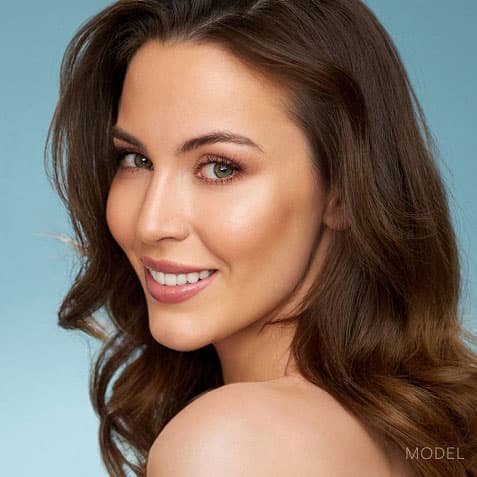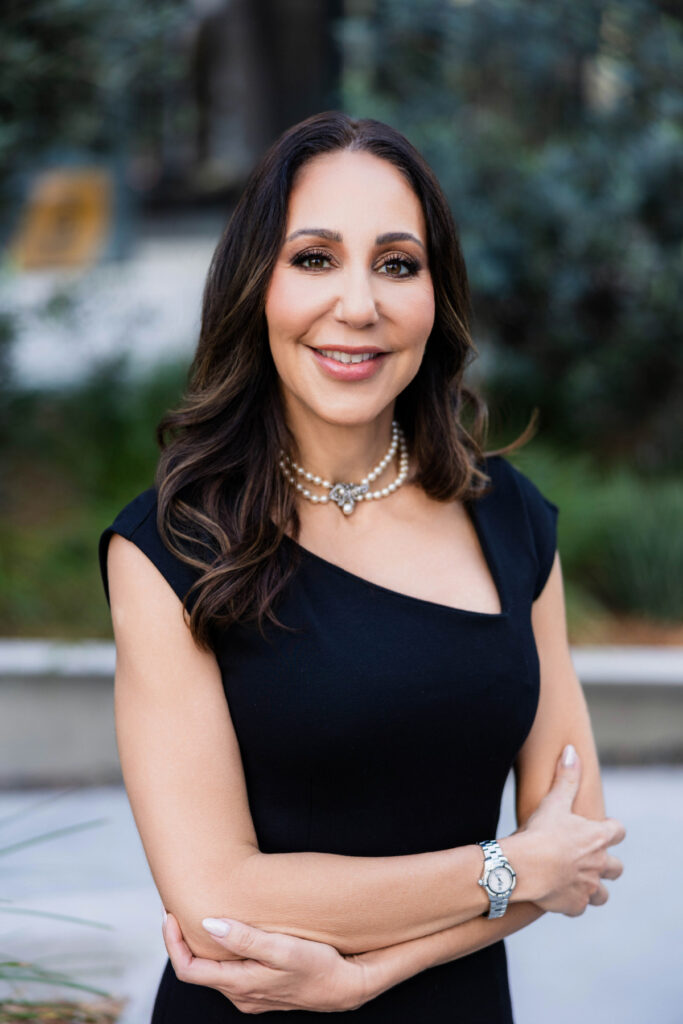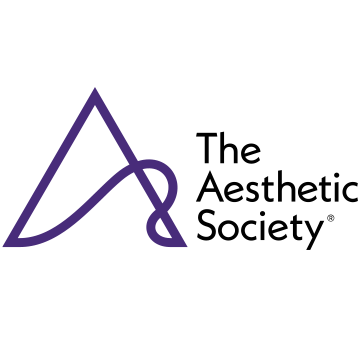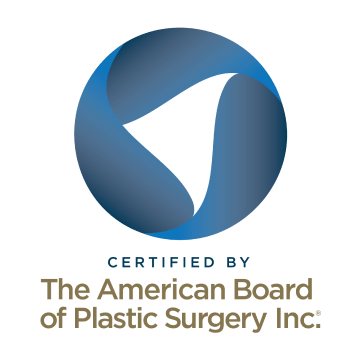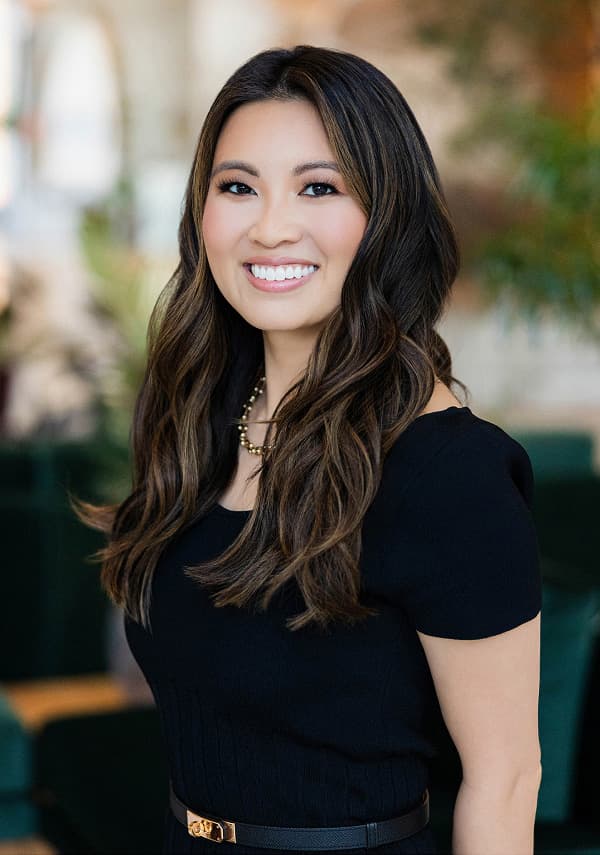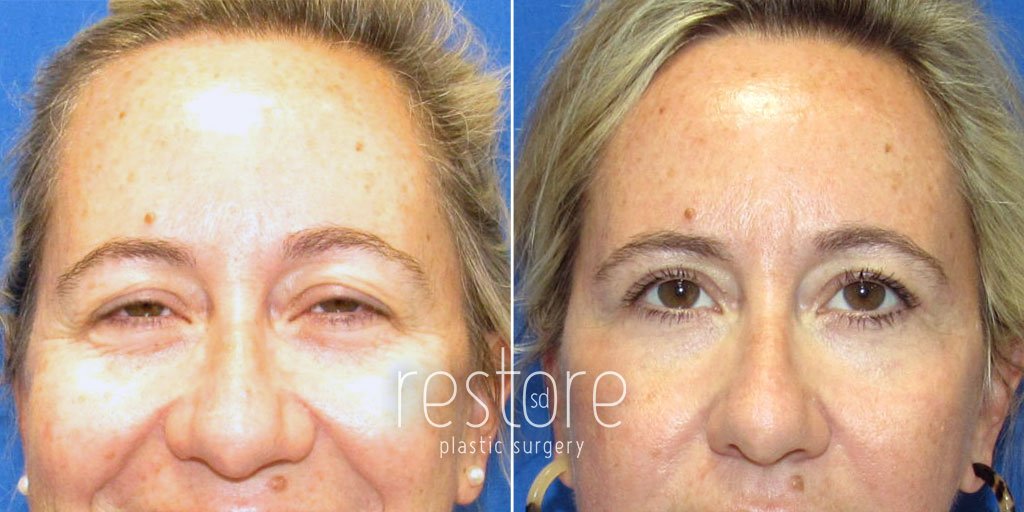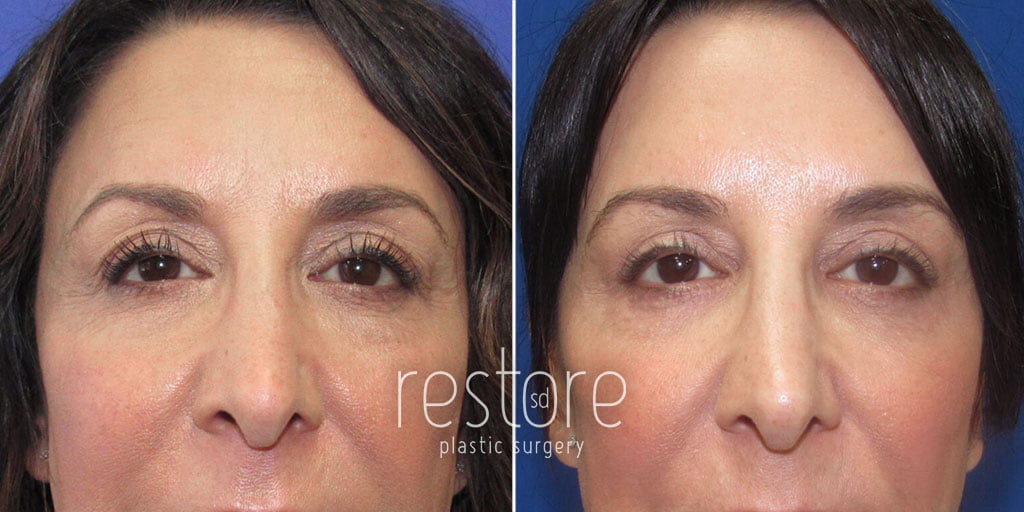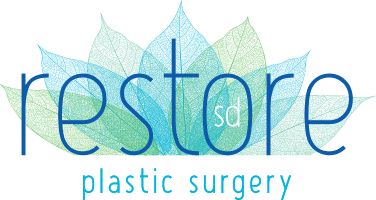Eyelid Lift San Diego
The Best Eyelid Lift San Diego Candidates
- Heavy upper eyelids or excess skin of your eyelids
- Suffer from eye fatigue at night
- Puffy bags or excess skin of your lower eyelids
- Have up-to-date lens prescriptions and do not suffer from dry eyes
- Do not have a history of serious eye trauma, Grave’s disease, or uncontrolled glaucoma
- Healthy, non-smoker, and not taking any blood thinner medication
With over 20 years of experience, Dr. Gallus is a board certified plastic surgeon and Castle Connolly Top Doctor. She will partner with you to develop a tailored surgical plan that prioritizes your safety and results.
Dr. Chao’s elite facial plastic surgery training and remarkable attention to detail offers patients safe, natural-looking results. She will work closely with you to understand your goals and concerns to bring your aesthetic vision to life.
Eyelid Lift Options
The gold standard for eyelid rejuvenation is surgical removal of excess skin and tissue. Upper eyelid surgery entails removal of the upper eyelid skin, a small amount of muscle, and occasionally some fat. Other treatment modalities to rejuvenate the upper eyelids and surrounding areas include laser therapy, injectable fillers, fat grafting, and neuromodulators such as BOTOX® Cosmetic, Daxxify®, and Dysport®. Although these complementary procedures provide a measure of eyelid rejuvenation they are often not as effective as blepharoplasty.
Lower eyelid surgery is less commonly performed due to these alternative treatment options which can be effective and less invasive. Lower blepharoplasty can be performed through an incision in the lower eyelid skin or via an incision on the inner aspect of the eyelid depending on your surgical goals.
The expert surgeons at Restore SD will perform a thorough evaluation and partner with you to develop an eyelid rejuvenation plan that will effectively and safely optimize your results.
Eyelid Lift Surgery
Upper blepharoplasty can be performed in the office setting with local anesthesia, at an ambulatory surgery center setting under sedation, or with general anesthesia. The type of anesthesia is dependent on your comfort level and safety standards that account for any medical conditions you may have. The surgery generally takes about an hour. Once the anesthesia is in place the surgeon will make incisions in the upper eyelid and carefully remove the skin and a small strip of muscle. Rarely, some fat is also removed through this incision. Your surgeon will then close the incision with a very fine suture and apply eye ointment. You will have ice packs applied immediately after surgery and be positioned with your head elevated.
Lower blepharoplasty is typically performed in conjunction with upper eyelid surgery and accomplished in the ambulatory surgery center under general anesthesia. This surgery takes 1-2 hours. Your Restore SD plastic surgeon will make a lower eyelid incision either in the skin (if excess skin is to be removed) or through the inner eyelid (if fat only is being removed). The excess tissue is carefully removed and the remaining skin and fat is re-draped to smooth the lower lid contour and blend the lid-cheek junction. The lower lid is usually supported with an internal suture and the incision is carefully closed with very fine suture. Ice packs and ointment are applied to assist in your comfort during recovery.
Certain laser treatments can be effective in tightening and smoothing the lower eyelid skin. Not everyone is a candidate for this form of therapy and your Restore SD surgeon will discuss the best options with you to help you achieve your goals.
Eyelid Lift Recovery
Once you have recovered from the anesthesia you can return home, as blepharoplasty is an outpatient surgery. You should arrange to have a responsible adult drive you home and stay with you for the next one to two days. Some surgical pain is expected and treated with pain medications. In the immediate post-operative period, your eyelids are swollen and vision is blurry due to the ointment, usually returning to normal over the next day.
Most patients can return to work after 1 to 2 weeks. It is generally safe to start applying makeup after 2 weeks. Normal activities such as showering, eating and light activity such as walking can be resumed within 24 hours after surgery. Some post-operative swelling is normal and resolves in the first 4 weeks in the typical patient. Lymphatic massage post-blepharoplasty can assist in reducing under-eye puffiness and bruising. You should refrain from intense physical activity for 4 weeks.
During the recovery period, you will have follow-up with your Restore SD surgeon and will be guided back to your usual activities. Most complications occur from getting too active too early, so select a surgical date that allows an appropriate amount of time to heal and gradually return to your more vigorous activities.
Combining Eyelid Lift with Other Procedures
Blepharoplasty is often performed in conjunction with other facial rejuvenation procedures, most commonly brow lift and facelift. It can be combined with laser resurfacing, BOTOX® Cosmetic, dermal filler injections, or fat grafting. Blepharoplasty can also be combined with breast augmentation, tummy tuck, liposuction, or surgery to enhance other areas. In your consultation, either Dr. Katerina Gallus or Dr. Janet Chao will talk with you about which procedures can be safely performed at the same time.

“I recently had surgery at Restore. I had several procedures performed. I contacted Restore for a consultation. The consultation is what convinced me to use Restore. I had several other consultations and none compared to Restore SD. There was no hard sales pitch or recommendation to have a procedure done that was more than what was needed. At Restore the office staff is friendly, patient and knowledgeable. The surgical staff was beyond wonderful. This wasn’t my first experience with plastic surgery and by far Restore has been the best… I am six weeks post op and am looking forward to seeing the complete results at the end of six months. I highly recommend Restore SD.”
—Real patient review
Eyelid Lift FAQs
What happens at my eyelid lift consultation?
When you arrive at Restore SD Plastic Surgery to discuss a possible eyelid lift, your Restore SD surgeon will perform a thorough medical exam and detailed facial analysis as well as review your medical history and any medications you are taking. At your consultation, you will have photos taken with our Vectra 3-D imaging system and discuss treatment areas and options while viewing your photos series. This ensures you can address all areas of concern with your surgeon. With our state-of-the-art Canfield software, potential surgical results can be viewed and adjustments can be made, helping you to visualize possible outcomes.
Will I be in much pain?
Your comfort is our top priority at Restore SD Plastic Surgery, so we perform your blepharoplasty in a calming environment and go above and beyond to provide you with the highest level of care. We also offer Pro-Nox, a patient-controlled pain management system that allows you to administer your own pain relief. Learn more about Pro-Nox here»
How long do the results of eyelid lift surgery last?
The results of both upper and lower blepharoplasty surgeries are quite durable. The swelling and scars generally heal very well and patients are happy for many years with their more youthful and energetic appearance. There are many factors that determine the length of time that a surgical procedure lasts and your surgeon will discuss a comprehensive aftercare program that includes sun protection and skin care.
View eyelid surgery before & after photos »
Why is eyelid lift surgery right for me?
Much like the double-chin, heavy and redundant upper and lower eyelid skin patterns can be passed along in families. In others, natural aging or weight loss can be the factors that stimulate interest in eyelid surgery. Over the years our patients consistently say that the fresh and well-rested look they see after eyelid surgery is one of the best treats they have given themselves.
- Key Benefits
- Glossary
- Addresses drooping eyelids (ptosis) that can give a tired or aged appearance
- Reduces or eliminate under-eye bags, making the eyes look brighter and less tired
- Removes excess skin that can droop and impair vision
- Anesthesia: Medication used during surgery to relieve pain and alter consciousness; in eyelid surgery, local anesthesia with sedation or general anesthesia may be used.
- Blepharoplasty: The medical term for eyelid surgery, a procedure designed to remove excess skin, fat, and muscle from the upper and/or lower eyelids.
- Canthopexy: A surgical technique used to tighten the lower eyelid by repositioning the lateral canthal tendon, often performed to correct eyelid drooping or create a more almond-shaped eye.
- Ectropion: A condition where the lower eyelid turns outward away from the eye; it is a potential complication of eyelid surgery that may require correction.
- Edema: Swelling caused by excess fluid trapped in the body’s tissues, which is common after eyelid surgery but typically subsides as healing progresses.
- Incisions: Surgical cuts made during the procedure; in eyelid surgery, they are strategically placed in the crease of the upper eyelid or just below the lashes in the lower lid to minimize visible scarring.
- Lower Blepharoplasty: Eyelid surgery focused on the lower eyelid, aimed at removing or repositioning fat deposits, tightening skin, and improving under-eye contours.
- Ptosis: Drooping of the upper eyelid that can impair vision; can be corrected surgically during eyelid lift surgery.
- Recovery: The period following surgery during which the body heals and recovers; for eyelid surgery, patients typically experience minimal discomfort and can return to normal activities within 1-2 weeks.
- Transconjunctival Blepharoplasty: A technique used in lower eyelid surgery where incisions are made inside the eyelid to remove or reposition fat without leaving visible scars.
- Upper Blepharoplasty: Eyelid surgery focused on the upper eyelid, aimed at removing excess skin and fat to restore a more youthful and refreshed appearance to the eyes.
How do I choose an eyelid lift surgeon?
It is important to ask if your surgeon has the proper qualifications. Years of training and expertise in facial rejuvenation surgery that cannot be imitated by short courses and alternative certifications. Ensure that your surgeon is proficient in facial rejuvenation surgery and eyelid surgery in particular.
Why should I choose Restore SD for my eyelid lift surgery?
Dr. Gallus holds over 20 years of experience with cosmetic and reconstructive surgery and is a fully credentialed, board-certified plastic surgeon. She also takes the time to listen to you, and partners with you to develop a surgical plan that prioritizes your safety and beautiful results.
Dr. Janet Chao is a distinguished facial plastic surgeon who specializes in aesthetic surgery of the face and neck. With over a decade dedicated to studying and perfecting techniques for the face and neck, Dr. Chao brings great care and expertise to the patients of Restore SD Plastic Surgery.
Our Restore SD surgeons use our VECTRA 3D camera system to take a detailed three-dimensional photo of your face. We then perform a complete facial analysis and demonstrate the potential outcomes of various procedures using the Canfield imaging software. Viewing potential outcomes with you allows us to use our years of experience to deliver a safe, quality, and age-appropriate facial rejuvenation surgery that will leave you looking and feeling younger and more self-confident.
I have dry eyes – can I have eyelid lift surgery?
Dry eyes are a common condition and are frequently treated with lubricating eye drops. Upper and lower eyelid lift surgery can worsen dry eye symptoms during the recovery period and, in some cases, after healing is complete. It is important to discuss any dry eye symptoms with your Restore SD surgeon during your detailed consultation.
I wear contact lenses – how will eyelid lift surgery affect me?
During the healing process, you will need to wear your glasses. Contact lens wear can typically be resumed 10-14 days after eyelid surgery after the majority of the swelling has resolved. You will want to be cautious with contact lens wear early on and will want to keep a pair of glasses close by in case your eyes becomes dry or irritated.
How much time off work should I take after eyelid lift surgery?
Depending on your profession, you should expect to take 1-2 weeks off from work. You will not be able to drive until your vision is clear and you are no longer taking narcotic pain medications. You will need a ride home after having general anesthesia and have a friend or family member stay with you for the first night and a day or two if possible.
How do I minimize post-operative scarring after eyelid lift surgery?
Dr. Gallus and Dr. Chao will educate you about scar management postoperatively. A surgical scar will take 9-12 months to fully mature. Your scar will go through changes during the healing process, and your Restore SD team will help you manage this part of your recovery. This can consist of sun avoidance, scar massage, scar cream, and fractionated laser treatments.
What should I do to prepare for eyelid lift surgery?
If you have close friends or relatives who have had eyelid lift surgery – start there! A personal story of their journey may guide you to questions to ask your surgeon, and having someone with a shared experience is invaluable. Educate yourself by reading our procedure page and viewing our educational videos. Other sources of information include RealSelf and WebMD. It is a good idea to invest in a glamorous pair of sunglasses to shield your eyes from damaging solar rays during the first few weeks of recovery.
Your Safety = Beautiful Results
Eyelid Lift at Restore SD
At Restore SD Plastic Surgery, patient safety comes first. Board-certified plastic surgeon and former Navy plastic surgeon Dr. Katerina Gallus and facial plastic surgeon Dr. Janet Chao operate in a private, on-site Quad A-accredited surgery center, with state-of-the-art equipment and LED surgical lighting. Our plastic surgeons proudly work with a board-certified anesthesiologist and holds privileges at Scripps Memorial Hospital La Jolla.
I am a smoker – can I have eyelid lift surgery?
If you have close friends or relatives who have had eyelid lift surgery – start there! A personal story of their journey may guide you to questions to ask your surgeon, and having someone with a shared experience is invaluable. Educate yourself by reading our procedure page and viewing our educational videos. It is a good idea to invest in a glamorous pair of sunglasses to shield your eyes from damaging solar rays during the first few weeks of recovery.
I have Diabetes – what do I need to know about eyelid lift surgery?
If you have diabetes it is important to work with your medical team to maintain an ideal HgbA1C. Diabetes can increase your risk for prolonged wound healing and certain types of infections. Surgery can be safely performed but requires a coordinated effort from patients, surgeons, and medical doctors to attain outstanding results. There are some instances where your Restore SD surgeon may want to postpone surgery until your diabetes is under better control.
How soon can I travel after having eyelid lift surgery?
Having surgery means a commitment to an appropriate recovery. We recommend scheduling your surgery at a time that allows enough time to recover and gradually return to your normal activities. Flying, driving long distances, or leaving the immediate area are not recommended until you have been cleared by your surgeon. If you have specific travel needs or require advice for emergency travel soon after a procedure, please let us know and we will be glad to discuss the details with you.
Let’s do this!
To get started, request your consultation online or give us a call at 858-224-228.
Call to schedule your consultation today »
References »
Naik MN, Honavar SG, Das S, Desai S, Dhepe N. Blepharoplasty: an overview. J Cutan Aesthet Surg. 2009 Jan;2(1):6-11. doi: 10.4103/0974-2077.53092. PMID: 20300364; PMCID: PMC2840922.
Finsterer J. Ptosis: causes, presentation, and management. Aesthetic Plastic Surgery. 2003 May-Jun;27(3):193-204. doi: 10.1007/s00266-003-0127-5.
Miotti G, Zeppieri M, Pederzani G, Salati C, Parodi PC. Modern blepharoplasty: From bench to bedside. World Journal of Clinical Cases. 2023 Mar 16;11(8):1719-1729. doi: 10.12998/wjcc.v11.i8.1719.
Rodrigues C, Carvalho F, Marques M. Upper Eyelid Blepharoplasty: Surgical Techniques and Results-Systematic Review and Meta-analysis. Aesthetic Plast Surg. 2023 Oct;47(5):1870-1883. doi: 10.1007/s00266-023-03436-6. Epub 2023 Jul 10. PMID: 37430010; PMCID: PMC10581926.
Branham GH. Lower Eyelid Blepharoplasty. Facial Plastic Surgery Clinics of North America. 2016 May;24(2):129-38. doi: 10.1016/j.fsc.2015.12.004.
Medically reviewed by Dr. Katerina Gallus — Updated on Mar 21, 2025
Learn more about procedures related to eyelid lifts in San Diego
 Can a Brow Lift Raise Eyelids Like a Blepharoplasty?
Can a Brow Lift Raise Eyelids Like a Blepharoplasty? Enjoy a Younger Look with Eyelid Lift Surgery (Blepharoplasty)
Enjoy a Younger Look with Eyelid Lift Surgery (Blepharoplasty) How a Brow Lift Can Make You Look Younger
How a Brow Lift Can Make You Look Younger

